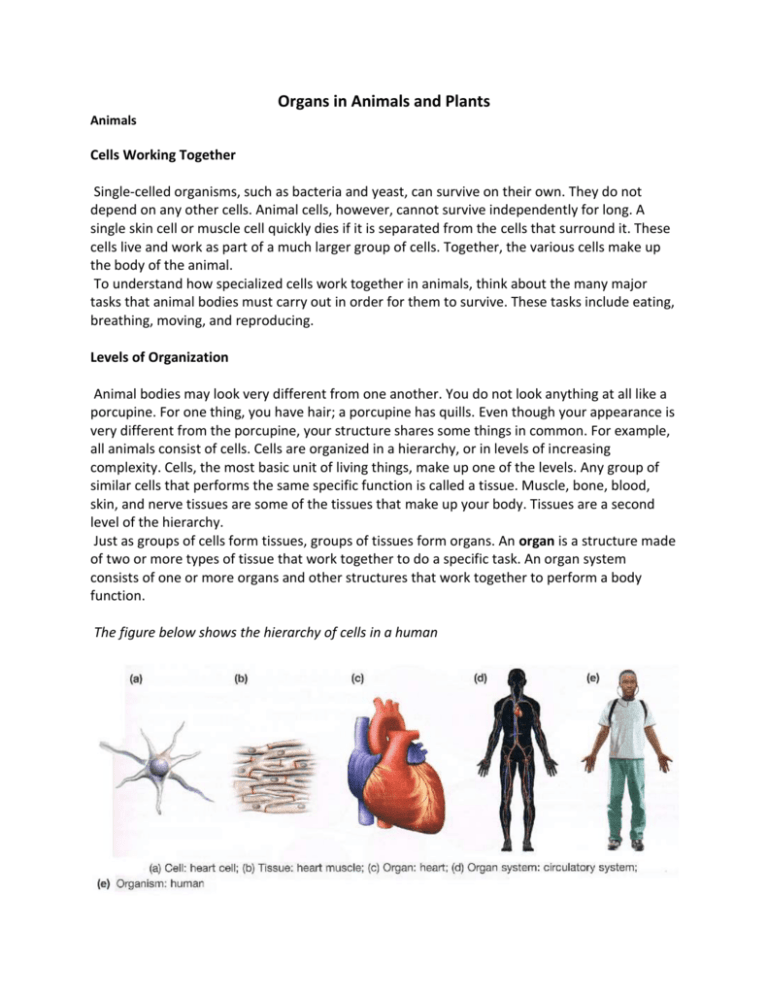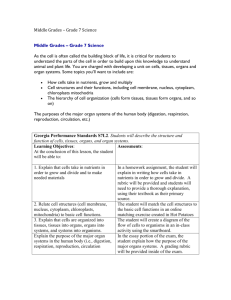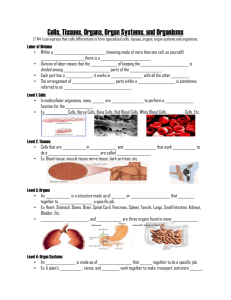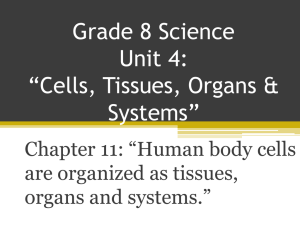g) Organs in Animals and Plants
advertisement

Organs in Animals and Plants Animals Cells Working Together Single-celled organisms, such as bacteria and yeast, can survive on their own. They do not depend on any other cells. Animal cells, however, cannot survive independently for long. A single skin cell or muscle cell quickly dies if it is separated from the cells that surround it. These cells live and work as part of a much larger group of cells. Together, the various cells make up the body of the animal. To understand how specialized cells work together in animals, think about the many major tasks that animal bodies must carry out in order for them to survive. These tasks include eating, breathing, moving, and reproducing. Levels of Organization Animal bodies may look very different from one another. You do not look anything at all like a porcupine. For one thing, you have hair; a porcupine has quills. Even though your appearance is very different from the porcupine, your structure shares some things in common. For example, all animals consist of cells. Cells are organized in a hierarchy, or in levels of increasing complexity. Cells, the most basic unit of living things, make up one of the levels. Any group of similar cells that performs the same specific function is called a tissue. Muscle, bone, blood, skin, and nerve tissues are some of the tissues that make up your body. Tissues are a second level of the hierarchy. Just as groups of cells form tissues, groups of tissues form organs. An organ is a structure made of two or more types of tissue that work together to do a specific task. An organ system consists of one or more organs and other structures that work together to perform a body function. The figure below shows the hierarchy of cells in a human Organ Systems and Organs How are the basic life functions performed by the human body? Organ systems carry them out. Here are a list of human organ systems and their functions: Nervous system Gathers information from the body and its surroundings and sends messages between the brain and the body Respiratory system Takes in oxygen from the air and removes carbon dioxide from the body Reproductive system Produces specialized egg cells in females and sperm cells in males and contains structures for internal fertilization, pregnancy, and live birth Musculoskeletal system Protects internal structures, supports the body, and allows the body to move Circulatory system Transports oxygen, nutrients, wastes, hormones, and other substances to and from all the cells in the body Digestive system Breaks down food and releases nutrients to the body’s cells Excretory system Helps maintain the correct balance of water in the body and removes waste Organs Groups of organs work together as organ systems to perform specific functions. For example, the digestive system is made up of many organs, including the stomach, small and large intestines, liver, and pancreas. The organs themselves are made up of two or more kinds of tissue. Let’s take a closer look at the stomach. The stomach is made up of tissues that help it carry out its task of breaking down food. Stomach tissues are made up of specialized cells, including muscle cells, nerve cells, blood cells, cells that line the outside and the inside of the stomach, and cells that secrete enzymes, acid, and mucus. Together, the tissues mix and break down the food we have eaten, getting it ready to be absorbed and delivered to the rest of the body. Plants A flowering plant is made up of four types of plant tissues: epidermal, ground, vascular, and meristematic. These plant tissues group together to form organs that perform special functions for the plant. The organs in a plant are the roots, the leaves, the stem, and the flower or fruit. The Roots The roots anchor the plant in the soil, which permits the plant to grow above the soil without toppling over. Roots collect water from the surrounding soil and transport it to the stem, and store food that is made in other parts of the plant. The Leaf The tissues in a leaf work together to accomplish photosynthesis. The vascular tissue carries water needed for photosynthesis from the root up the stem to the leaf The Stem Transports water and nutrients throughout the plant Supports the leaves and flowers The Flower The reproductive structure of the plant Produces seeds through sexual reproduction The flower contains male organs, called stamens. Each stamen consists of a filament with an anther at the tip. The anther produces pollen, which are the male sex cells. The flower also contains female organs, called the pistil, which consists of the ovary, style, and stigma. Female sex cells, called eggs, are located in the ovary. When the pollen and an egg unite, the fertilized egg becomes a seed. Some seeds are surrounded by flesh and are called the fruit. Questions: 1. What is an organ? Give an example of an animal organ and a plant organ. 2. What does an organ system do? 3. How are tissues and organs related? 4. Choose a function that all living things must perform. Describe the organ system that performs this function. 5. Why are organs such as the lungs, heart, and stomach made up of many different kinds of specialized cells rather than only one kind? 6. Most animals have many of the same organ systems. Why do you think there are not many different kinds of organs and systems when animals are so different? 7. List and provide the main function for the four organs of the plant.







